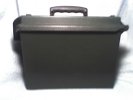|
This isn't an easy question to answer. There are tools available, such as Radio Mobile (recommend the online version at http://www.cplus.org/rmw/rmonline.html), which will help you determine path feasibility, the power/antenna gain you'll need to make the distance, etc. Many of us have successful links of 10 miles and some even 20 miles or more... but the devil is in the details. I suspect you will not get 10 miles with a 10 dBi omni antenna and .4 watts unless the other end a dish with 20-30 dBi of gain range. Rather, consider one or more sector antennas. UBNT makes several of these as well. Above all, the paths and their Fresnel Zones will need to be clear of vegetation. You mention the area is forested. This will kill 2.4 GHz and above. You may want to consider 900 MHz if you have no choice but to shoot through vegetation. But at 900 MHz you'll need to constrain the bandwidth to 5 MHz to respect other users and be careful to coordinate your channel with other local uses for the band. So, as you can see, it's a complex question. If you haven't already done so, I recommend to you and anyone planning a deployment to download and read Wireless Networking in the Developing World (http://wndw.net/). It'll give you all the background you'll need to successfully implement a mesh. To answer the comparison question: - The Rocket TX power is 28 dBm and the vertical is 10 dBi for a total of 38 dB.
- The NanoStation power is 28 dBm and the integrated antenna is 11 dBi for a total of 39 dB.
So they are equivalent within their antenna radiation patterns, but the Nanostation only has a 55 degree radiation pattern. Remember that signal loss over distance follows the inverse-square law, so doubling the distance between nodes requires an additional 6 dB of power or antenna gain. Achieving that 6 dB through antenna gain improves the link in both directions. Achieving it with additional transmitter power only helps in that one direction. Andre, K6AH |
